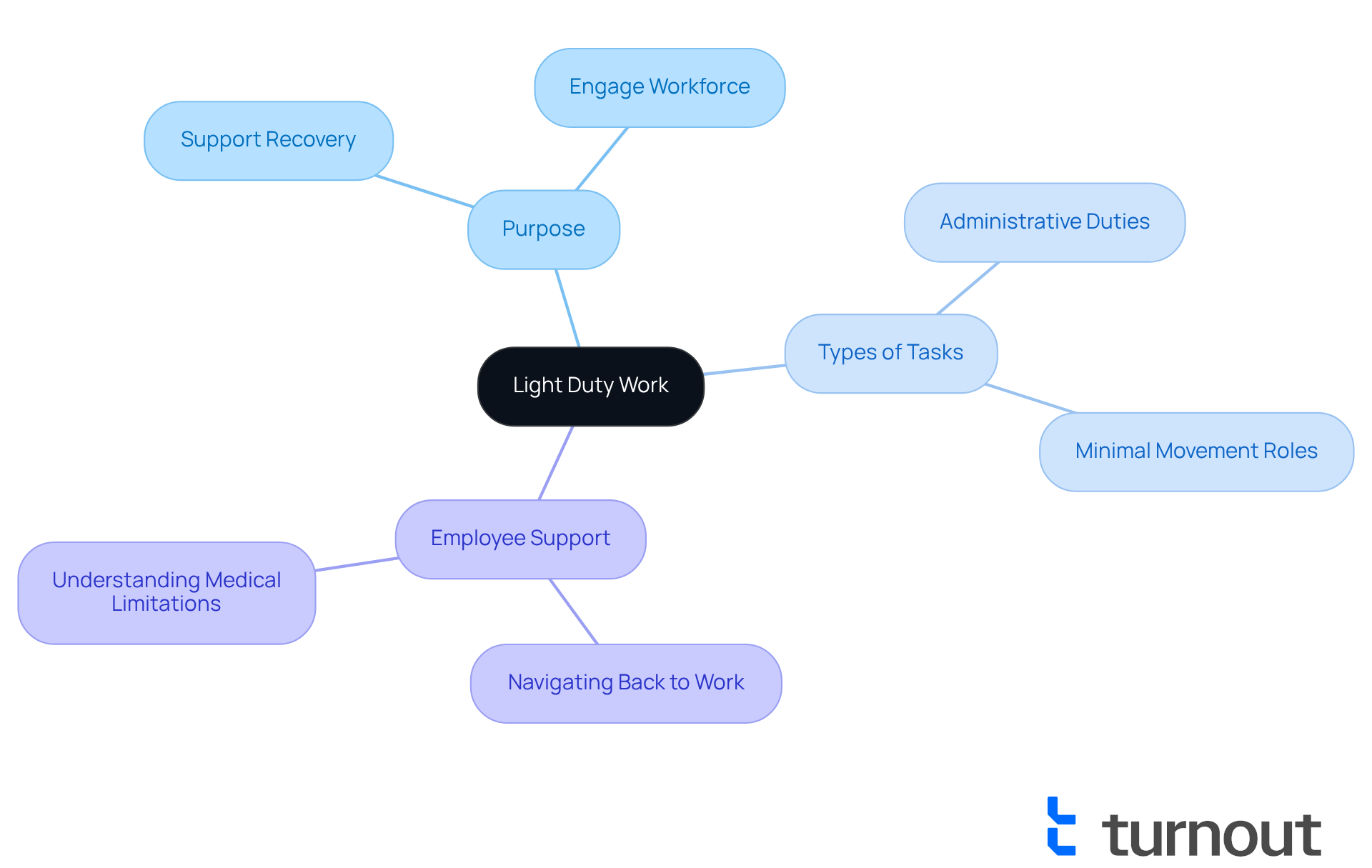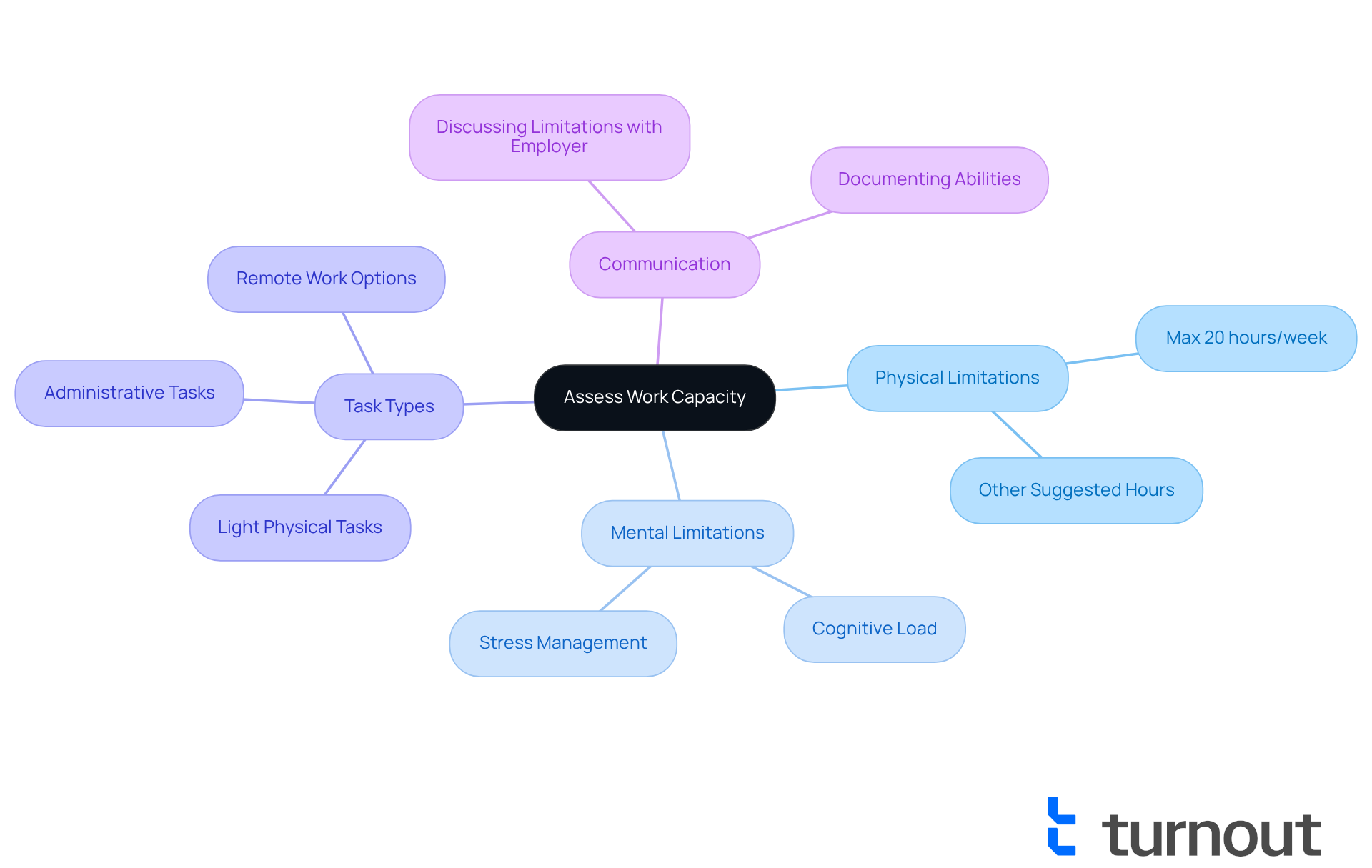Overview
The article thoughtfully addresses how many hours one can work on light duty, emphasizing the importance of assessing your individual capacity and communicating any limitations with your employer. We understand that navigating this situation can be challenging, which is why it's crucial to consider both physical and mental health guidelines provided by healthcare professionals. This ensures that your work assignments align with your recovery needs.
It's common to feel uncertain about how to balance work and recovery, but rest assured, you have legal rights that protect you during this time. Remember, you are not alone in this journey. We’re here to help you navigate these important considerations with care and compassion.
Introduction
Navigating the complexities of light duty work can feel overwhelming for employees recovering from injuries or illnesses. These modified job assignments serve not merely as a temporary solution; they play a vital role in keeping individuals engaged in the workforce while honoring their medical limitations.
We understand that it can be challenging to grasp how many hours one can work under these conditions. This raises important questions about your rights, responsibilities, and the potential for conflicts with employers.
What steps can you take to ensure your recovery is not compromised while fulfilling your work duties? You're not alone in this journey; we're here to help.
Define Light Duty Work and Its Purpose
Light work refers to modified job assignments that are designed to support employees as they recover from injuries or illnesses. We understand that returning to work can be a challenging journey. The primary goal of these modified responsibilities is to help individuals remain engaged in the workforce while respecting their medical limitations. This can include tasks that are less physically demanding, such as administrative duties or roles that require minimal movement.
It's vital to comprehend the meaning and objective of these minimal task assignments. By doing so, employees can better support their entitlements and ensure they are not placed in roles that might jeopardize their recovery. Remember, you are not alone in this journey; we’re here to help you navigate your path back to work with care and understanding.

Understand Legal Rights and Employer Responsibilities
Workers have important rights when it comes to modified work. You have the right to decline tasks that don't align with your medical limitations. It's essential for employers to provide appropriate adjustments, which may include creating modified roles just for you.
We understand that communicating your limitations can be challenging. It's vital to have open conversations with your employer about these needs, including how many hours you can work on light duty assignments, and to document any agreements. By becoming familiar with both your rights and responsibilities, you can help prevent misunderstandings and ensure a smoother return to your duties.
Remember, you are not alone in this journey. We're here to help you navigate these challenges with compassion and understanding.

Assess Your Work Capacity and Hour Limitations
We understand that evaluating your capacity can be challenging. It's important to consider both your physical and mental limitations as outlined by your healthcare provider. This might mean recognizing how many hours you can work without exacerbating your condition. For example, if your doctor suggests a maximum of 20 hours per week, communicating this to your employer is crucial.
Additionally, think about the types of tasks you can perform comfortably. Keeping a record of your abilities can be incredibly helpful during conversations with your employer. This ensures that your assigned tasks align with your recovery objectives. Remember, you're not alone in this journey, and we're here to help you navigate through it.

Explore Options if Employer Violates Light Duty Restrictions
If you believe your employer is violating your light duty restrictions, it's crucial to take immediate action. We understand that this can be a challenging situation. Start by documenting any instances where you are assigned tasks that exceed your limitations. Communicate your concerns to your supervisor or HR department, and provide them with a copy of your medical restrictions.
If the issue persists, consider filing a complaint with the appropriate regulatory body or seeking assistance from a consumer advocacy organization. Remember, taking these steps can help ensure that your rights are upheld. You deserve to continue your recovery without unnecessary setbacks, and we're here to help you navigate this journey.

Conclusion
Navigating the complexities of light duty work is essential for employees recovering from injuries or illnesses. We understand that this can be a challenging journey, and recognizing the nature and purpose of light duty assignments is crucial. This understanding not only helps maintain engagement in the workforce but also ensures that individuals adhere to their medical limitations. It's vital to acknowledge your rights and responsibilities in this context for a smooth transition back to work.
Key insights from this guide highlight the importance of clear communication with employers regarding work capacity and hour limitations.
- Take a moment to assess your physical and mental abilities as outlined by your healthcare provider.
- This self-assessment ensures that assigned tasks align with your recovery goals.
- Additionally, being aware of your legal rights and options is essential should employers fail to respect light duty restrictions.
Ultimately, advocating for yourself in the workplace is paramount. You should feel empowered to document any violations of your light duty restrictions and take appropriate action when necessary. Remember, you are not alone in this journey. By understanding these dynamics, you can foster a supportive work environment that prioritizes your health and recovery, paving the way for a successful return to full duties.
Frequently Asked Questions
What is light duty work?
Light duty work refers to modified job assignments designed to support employees as they recover from injuries or illnesses, allowing them to engage in the workforce while respecting their medical limitations.
What is the purpose of light duty work?
The primary purpose of light duty work is to help individuals remain engaged in their jobs while accommodating their recovery needs, often involving tasks that are less physically demanding.
What types of tasks are included in light duty work?
Light duty work can include tasks such as administrative duties or roles that require minimal movement, which are less physically demanding compared to regular job responsibilities.
How can understanding light duty work benefit employees?
Understanding light duty work helps employees support their entitlements and ensures they are not placed in roles that could jeopardize their recovery during their return to work journey.




